Structure of the 1,N(2)-etheno-2'-deoxyguanosine lesion in the 3'-G(epsilon dG)T-5' sequence opposite a one-base deletion
- PMID: 20201499
- PMCID: PMC2844103
- DOI: 10.1021/bi901516d
Structure of the 1,N(2)-etheno-2'-deoxyguanosine lesion in the 3'-G(epsilon dG)T-5' sequence opposite a one-base deletion
Abstract
The structure of the 1,N(2)-ethenodeoxyguanosine lesion (1,N(2)-epsilondG) has been characterized in 5'-d(CGCATXGAATCC)-3'.5'-d(GGATTCATGCG)-3' (X = 1,N(2)-epsilondG), in which there is no dC opposite the lesion. This duplex (named the 1-BD duplex) models the product of translesion bypass of 1,N(2)-epsilondG by Sulfolobus solfataricus P2 DNA polymerase IV (Dpo4) [Zang, H., Goodenough, A. K., Choi, J. Y., Irimia, A., Loukachevitch, L. V., Kozekov, I. D., Angel, K. C., Rizzo, C. J., Egli, M., and Guengerich, F. P. (2005) J. Biol. Chem. 280, 29750-29764], leading to a one-base deletion. The T(m) of this duplex is 6 degrees C higher than that of the duplex in which dC is present opposite the 1,N(2)-epsilondG lesion and 8 degrees C higher than that of the unmodified 1-BD duplex. Analysis of NOEs between the 1,N(2)-epsilondG imidazole and deoxyribose H1' protons and between the 1,N(2)-epsilondG etheno H6 and H7 protons and DNA protons establishes that 1,N(2)-epsilondG adopts the anti conformation about the glycosyl bond and that the etheno moiety is accommodated within the helix. The resonances of the 1,N(2)-epsilondG H6 and H7 etheno protons shift upfield relative to the monomer 1,N(2)-epsilondG, attributed to ring current shielding, consistent with their intrahelical location. NMR data reveal that Watson-Crick base pairing is maintained at both the 5' and 3' neighbor base pairs. The structure of the 1-BD duplex has been refined using molecular dynamics calculations restrained by NMR-derived distance and dihedral angle restraints. The increased stability of the 1,N(2)-epsilondG lesion in the absence of the complementary dC correlates with the one-base deletion extension product observed during the bypass of the 1,N(2)-epsilondG lesion by the Dpo4 polymerase, suggesting that stabilization of this bulged intermediate may be significant with regard to the biological processing of the lesion.
Figures


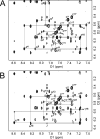
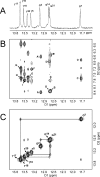

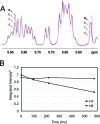
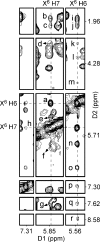



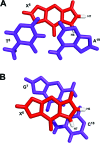
Similar articles
-
1,N2-Etheno-2'-deoxyguanosine adopts the syn conformation about the glycosyl bond when mismatched with deoxyadenosine.Chem Res Toxicol. 2011 Jul 18;24(7):1071-9. doi: 10.1021/tx200089v. Epub 2011 Jun 16. Chem Res Toxicol. 2011. PMID: 21675798 Free PMC article.
-
Orientation of the crotonaldehyde-derived N2-[3-Oxo-1(S)-methyl-propyl]-dG DNA adduct hinders interstrand cross-link formation in the 5'-CpG-3' sequence.Chem Res Toxicol. 2006 Aug;19(8):1019-29. doi: 10.1021/tx0600604. Chem Res Toxicol. 2006. PMID: 16918240
-
Structure of the 1,N2-etheno-2'-deoxyguanosine adduct in duplex DNA at pH 8.6.Chem Res Toxicol. 2007 Nov;20(11):1601-11. doi: 10.1021/tx7001788. Epub 2007 Oct 18. Chem Res Toxicol. 2007. PMID: 17941687 Free PMC article.
-
DNA conformation and dynamics.Radiat Environ Biophys. 1999 May;38(1):23-9. doi: 10.1007/s004110050134. Radiat Environ Biophys. 1999. PMID: 10384952 Review.
-
Investigation of unusual DNA motifs.Methods Enzymol. 2001;338:341-71. doi: 10.1016/s0076-6879(02)38228-4. Methods Enzymol. 2001. PMID: 11460557 Review. No abstract available.
Cited by
-
Etheno adducts: from tRNA modifications to DNA adducts and back to miscoding ribonucleotides.Genes Environ. 2021 Jun 16;43(1):24. doi: 10.1186/s41021-021-00199-x. Genes Environ. 2021. PMID: 34130743 Free PMC article. Review.
-
1,N2-Etheno-2'-deoxyguanosine adopts the syn conformation about the glycosyl bond when mismatched with deoxyadenosine.Chem Res Toxicol. 2011 Jul 18;24(7):1071-9. doi: 10.1021/tx200089v. Epub 2011 Jun 16. Chem Res Toxicol. 2011. PMID: 21675798 Free PMC article.
-
Recognition of 1,N2-ethenoguanine by alkyladenine DNA glycosylase is restricted by a conserved active-site residue.J Biol Chem. 2020 Feb 7;295(6):1685-1693. doi: 10.1074/jbc.RA119.011459. Epub 2019 Dec 27. J Biol Chem. 2020. PMID: 31882538 Free PMC article.
-
Next-generation sequencing reveals the biological significance of the N(2),3-ethenoguanine lesion in vivo.Nucleic Acids Res. 2015 Jun 23;43(11):5489-500. doi: 10.1093/nar/gkv243. Epub 2015 Apr 2. Nucleic Acids Res. 2015. PMID: 25837992 Free PMC article.
References
-
- Barbin A. (2000) Etheno-adduct-forming chemicals: From mutagenicity testing to tumor mutation spectra. Mutat. Res. 462, 55–69. - PubMed
-
- Barbin A.; Bresil H.; Croisy A.; Jacquignon P.; Malaveille C.; Montesano R.; Bartsch H. (1975) Liver-microsome-mediated formation of alkylating agents from vinyl bromide and vinyl chloride. Biochem. Biophys. Res. Commun. 67, 596–603. - PubMed
-
- Green T.; Hathway D. E. (1978) Interactions of vinyl chloride with rat-liver DNA in vivo. Chem.-Biol. Interact. 22, 211–224. - PubMed
-
- Eberle G.; Barbin A.; Laib R. J.; Ciroussel F.; Thomale J.; Bartsch H.; Rajewsky M. F. (1989) 1,N6-Etheno-2′-deoxyadenosine and 3,N4-etheno-2′-deoxycytidine detected by monoclonal antibodies in lung and liver DNA of rats exposed to vinyl chloride. Carcinogenesis 10, 209–212. - PubMed
-
- Fedtke N.; Boucheron J. A.; Walker V. E.; Swenberg J. A. (1990) Vinyl chloride-induced DNA adducts. II: Formation and persistence of 7-(2′-oxoethyl)guanine and N2,3-ethenoguanine in rat tissue DNA. Carcinogenesis 11, 1287–1292. - PubMed
Publication types
MeSH terms
Substances
Grants and funding
LinkOut - more resources
Full Text Sources

